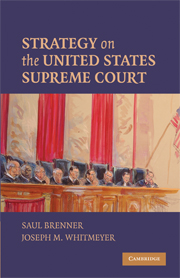Book contents
- Frontmatter
- Contents
- Preface
- PART I INTRODUCTION
- PART II CERTIORARI
- PART III THE CONFERENCE VOTE ON THE MERITS
- PART IV THE MAJORITY OPINION AND OTHER OPINIONS
- PART V THE FINAL VOTE ON THE MERITS
- PART VI CONCLUDING CHAPTERS
- Appendix 1 Decision Making on the United States Supreme Court
- Appendix 2 Additional Questions to Explore
- References
- Table of Cases
- Index
Appendix 2 - Additional Questions to Explore
Published online by Cambridge University Press: 05 June 2012
- Frontmatter
- Contents
- Preface
- PART I INTRODUCTION
- PART II CERTIORARI
- PART III THE CONFERENCE VOTE ON THE MERITS
- PART IV THE MAJORITY OPINION AND OTHER OPINIONS
- PART V THE FINAL VOTE ON THE MERITS
- PART VI CONCLUDING CHAPTERS
- Appendix 1 Decision Making on the United States Supreme Court
- Appendix 2 Additional Questions to Explore
- References
- Table of Cases
- Index
Summary
There are a host of additional questions that can be explored with strategic and other theoretical tools. Consider the following:
Why have recent Courts granted cert to many fewer cases than in the past? During the 1970 through the 1978 terms, for example, the Court granted cert to more than 200 paid petitions per term (Epstein, Segal, Spaeth, and Walker, 2007, Table 2-6). In contrast, in the 1992 to 2007 era it never granted cert to 100 paid petitions in any term. Is it surprising that the justices do not hear as many cases as possible?
Why does the Court grant cert to cases “that do not possess any political significance” (Cross, 1998, p. 559)?
Why does the Court grant cert to many cases they affirm (Cross, 1998, p. 560)? Is this the best use of the Court's resources?
If the justices cast four votes to grant cert and five to deny cert, why do the five rarely vote to DIG (dismiss it as improvidently granted) the case (Segal and Spaeth, 2002, p. 435)?
“Given the advantage of speaking first and voting last, why in the world did the Chief Justice even begin voting first” (Segal and Spaeth, 2002, p. 435)? Note that the change took place when Warren was chief justice.
Brenner and Spaeth (1988) inspected minimum winning (MW; 5–4, 4–3) conference coalitions on the Warren Court and discovered that the marginal justice (i.e., the justice ideologically closest to the dissenters) was assigned to write the majority opinion more than twice as many times than can be expected based on random assignment. Why is this justice favored in this situation?
[…]
- Type
- Chapter
- Information
- Strategy on the United States Supreme Court , pp. 173 - 176Publisher: Cambridge University PressPrint publication year: 2009



